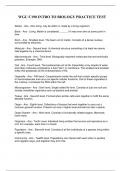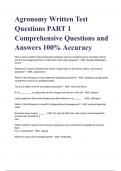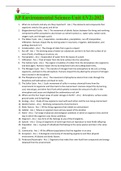Abiotic ans nonliving - Study guides, Class notes & Summaries
Looking for the best study guides, study notes and summaries about Abiotic ans nonliving? On this page you'll find 13 study documents about Abiotic ans nonliving.
Page 2 out of 13 results
Sort by

-
WGU C190 INTRO TO BIOLOGY PRACTICE TEST QUESTIONSQUESTIONS & ANSWERS (2024)(VERIFIED ANSWERS)
- Exam (elaborations) • 20 pages • 2024
- Available in package deal
-
- $2.99
- + learn more
WGU C190 INTRO TO BIOLOGY PRACTICE TEST Abiotic - Ans - Non-living, may be within or made by a living organism. Biotic - Ans - Living. Matter is considered ______ if it was ever alive at some point in time Atom - Ans - Smallest level. The basic unit of matter. Consists of a dense nucleus surrounded by electrons. Molecule - Ans - Second level. A chemical structure consisting of at least two atoms held together by a chemical bond. Macromolecule - Ans - Third level. Biologically importan...

-
Agronomy Written Test Questions PART 1 Comprehensive Questions and Answers 100% Accuracy
- Exam (elaborations) • 16 pages • 2024
-
- $8.49
- + learn more
Who is given credit for discovering that soybeans were an excellent source of protein and oil and for encouraging farmers to rotate their crops with soybeans? - ANS George Washington Carver What term is used to describe fine brown or gray hairs on the leaves, stems, and pods of soybeans? - ANS pubescence Which of the following is a true statement regarding soybeans? - ANS Soybeans are generally considered a source of complete protein. The top 2 states in terms of soybean production?...

-
SOLVED - Elaborated AP Environmental Science-Unit 1 Version 2-2023
- Exam (elaborations) • 7 pages • 2023
-
- $14.49
- + learn more
SOLVED - Elaborated AP Environmental Science-Unit 1 Version 2-2023 What are nutrients and why are they important? - Ans | The elements and compounds that organisms need to live, grow, and thrive 2. Biogeochemical Cycles - Ans | The movement of abiotic factors between the living and nonliving components within ecosystems; also known as nutrient cycles (i.e., water cycle, carbon cycle, oxygen cycle, and nitrogen cycle). 3. The Water Cycle - Ans | Evaporation, condensation, precipitation, run of...

Do you wonder why so many students wear nice clothes, have money to spare and enjoy tons of free time? Well, they sell on Stuvia! Imagine your study notes being downloaded a dozen times for $15 each. Every. Single. Day. Discover all about earning on Stuvia


